
The Atchison, Topeka and Santa Fe Railway, often referred to as the Santa Fe or AT&SF, was one of the larger railroads in the United States. The railroad was chartered in February 1859 to serve the cities of Atchison and Topeka, Kansas, and Santa Fe, New Mexico. The railroad reached the Kansas–Colorado border in 1873 and Pueblo, Colorado, in 1876. To create a demand for its services, the railroad set up real estate offices and sold farmland from the land grants that it was awarded by Congress.

The Super Chief was one of the named passenger trains and the flagship of the Atchison, Topeka and Santa Fe Railway. The streamliner claimed to be "The Train of the Stars" because of the various celebrities it carried between Chicago, Illinois, and Los Angeles, California.
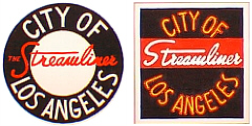
The City of Los Angeles was a streamlined passenger train between Chicago, Illinois, and Los Angeles, California via Omaha, Nebraska, and Ogden, Utah. Between Omaha and Los Angeles it ran on the Union Pacific Railroad; east of Omaha it ran on the Chicago and North Western Railway until October 1955 and on the Milwaukee Road thereafter. The train had number 103 westbound and number 104 eastbound.

The San Diegan was one of the named passenger trains of the Atchison, Topeka and Santa Fe Railway, and a “workhorse” of the railroad. Its 126-mile (203-kilometer) route ran from Los Angeles, California south to San Diego. It was assigned train Nos. 70–79.

The El Capitan was a streamlined passenger train operated by the Atchison, Topeka and Santa Fe Railway between Chicago, Illinois, and Los Angeles, California. It operated from 1938 to 1971; Amtrak retained the name until 1973. The El Capitan was the only all-coach or "chair car" to operate on the Santa Fe main line between Chicago and Los Angeles on the same fast schedule as the railroad's premier all-Pullman Super Chief. It was also the first train to receive the pioneering Hi-Level equipment with which it would become synonymous.
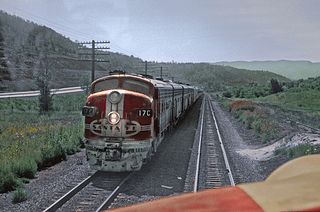
The Chief was a long-distance named passenger train of the Atchison, Topeka and Santa Fe Railway that ran between Chicago, Illinois and Los Angeles, California. The Santa Fe initiated the Chief in 1926 to supplement the California Limited. In 1936 the Super Chief was introduced, soon eclipsing the Chief as the standard bearer of the Santa Fe. The Chief was discontinued in 1968 due to high operating costs, competition from airlines, and the loss of Postal Office contracts.
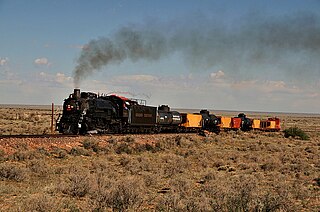
The Grand Canyon Railway is a heritage railroad which carries passengers between Williams, Arizona and the South Rim of Grand Canyon National Park.

Atchison, Topeka & Santa Fe 3751 is a class 3751 4-8-4 steam locomotive built in 1927 by the Baldwin Locomotive Works in Eddystone (Philadelphia), Pennsylvania for the Atchison, Topeka & Santa Fe Railway (ATSF). 3751 was the first 4-8-4 steam locomotive built for the Santa Fe and was referenced in documentation as type: "Heavy Mountain", "New Mountain", or "Mountain 4-wheel trailer". No. 3751 served in passenger duties until being retired in 1953.

The California Limited was one of the named passenger trains of the Atchison, Topeka and Santa Fe Railway. It carried train Nos. 3 & 4 and ran between Chicago, Illinois and Los Angeles, California.
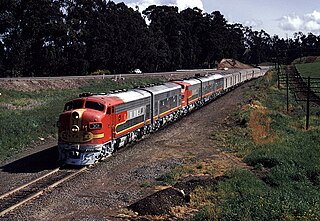
The San Francisco Chief was a streamlined passenger train on the Atchison, Topeka, and Santa Fe Railway between Chicago and the San Francisco Bay Area. It ran from 1954 until 1971. The San Francisco Chief was the last new streamliner introduced by the Santa Fe, its first full train between Chicago and the Bay, the only Chicago–Bay Area train running over just one railroad, and at 2,555 miles (4,112 km) the longest run in the country on one railroad. The San Francisco Chief was one of many trains discontinued when Amtrak began operations in 1971.

The Santa Fe de Luxe was the first extra-fare named passenger train on the Atchison, Topeka and Santa Fe Railway.

The Scout was one of the named passenger trains of the Atchison, Topeka and Santa Fe Railway. It started as train Nos. 1 (westbound) & 10 (eastbound) between Chicago, Illinois and Los Angeles, California. Inaugurated on January 16, 1916, this "budget" heavyweight train had tourist sleeping cars with upper and lower berths, "chair" cars (coaches) and an open-end observation car.

The Lone Star was an Amtrak passenger train that ran between Chicago and Houston, or Dallas via Kansas City, Wichita, Oklahoma City, and Fort Worth. The train was renamed from the Texas Chief, which the Atchison, Topeka and Santa Fe Railway had introduced in 1948. Amtrak discontinued the Lone Star in 1979.

The Scott Special, also known as the Coyote Special, the Death Valley Coyote or the Death Valley Scotty Special, was a one-time, record-breaking passenger train operated by the Atchison, Topeka and Santa Fe Railway from Los Angeles, California, to Chicago, Illinois, at the request of Walter E. Scott, known as "Death Valley Scotty". At the time of its transit in 1905, the Scott Special made the 2,265-mile (3,645 km) trip between the two cities at the fastest speed recorded to date; in doing so, it established the Santa Fe as the leader in high-speed travel between Chicago and the West Coast. The Scott Special made the trip in 44 hours and 54 minutes breaking the previous records, set in 1900 by the Peacock Special, by 13 hours and 2 minutes, and in 1903 by the Lowe Special, by 7 hours and 55 minutes. Santa Fe's regular passenger service from Los Angeles to Chicago at the time was handled on a 2½-day schedule by the California Limited. It was not until the 1936 introduction of the Super Chief that Santa Fe trains would regularly exceed the speeds seen on the Scott Special.
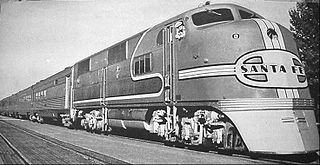
The Golden Gate was one of the named passenger trains of the Atchison, Topeka and Santa Fe Railway. It ran between Oakland and Bakersfield, California; its bus connections provided service between San Francisco and Los Angeles via California's San Joaquin Valley.
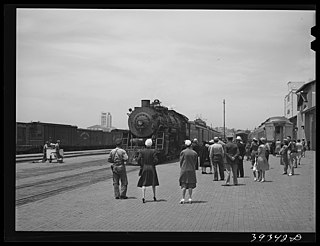
The Valley Flyer was a short-lived named passenger train of the Atchison, Topeka and Santa Fe Railway.
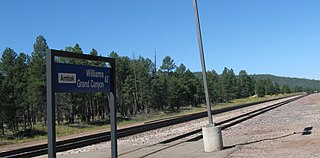
Williams Junction was an Amtrak train station on the Southwest Chief route, located three miles (4.8 km) southeast of Williams, Arizona in the Kaibab National Forest. The station primarily served passengers travelling to the Grand Canyon via the Grand Canyon Railway.

The Texas Chief was a passenger train operated by the Atchison, Topeka and Santa Fe Railway between Chicago, Illinois, and Galveston, Texas. It was the first Santa Fe "Chief" outside the Chicago–Los Angeles routes. The Santa Fe conveyed the Texas Chief to Amtrak in 1971, which renamed it the Lone Star in 1974. The train was discontinued in 1979.

The Chicagoan and Kansas Cityan were a pair of American named passenger trains operated by the Atchison, Topeka and Santa Fe Railway. They ran from Chicago, Illinois to Wichita, Kansas, with a later extension to Oklahoma City.

The Hi-Level was a type of bilevel intercity railroad passenger car used in the United States. Car types included coaches, dining cars, and lounge cars. Most passenger spaces were on the upper level, which featured a row of windows on both sides. Boarding was on the lower level; passengers climbed up a center stairwell to reach the upper level. Vestibules on the upper level permitted passengers to walk between cars; some coaches had an additional stairwell at one end to allow access to single-level equipment. Santa Fe and Budd considered but never created a sleeping car.






















